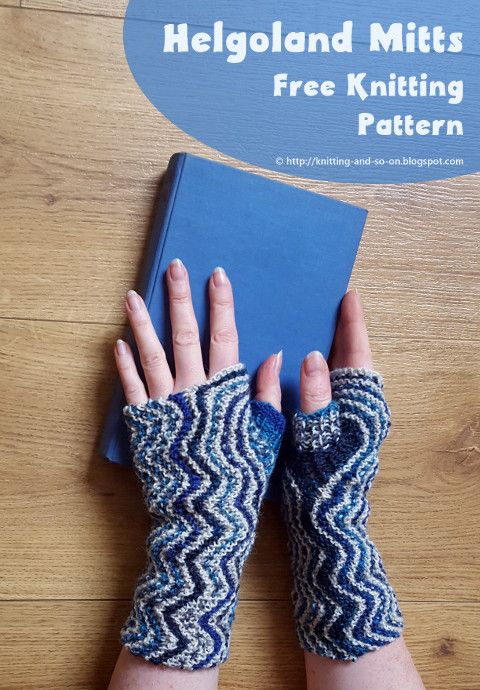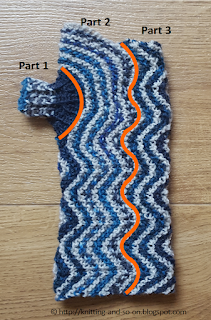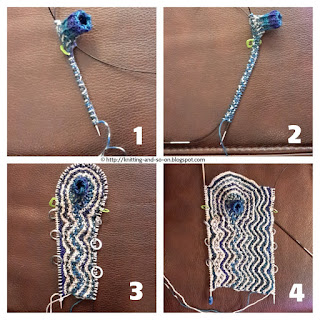I like fingerless gloves that are knitted in one piece - so that you only have to weave in 2 ends per glove. That's why I think it's a good idea to start fingerless gloves at the thumb ... there are already a few patterns like this available on my blog (e.g. Circle Mitts or Zimtsterne Mitts). However, these mitts are the first ones that I knitted in Sports weight yarn.
The pattern is written for one size only, but there are explanations on how to adjust the pattern to your size.
As to the name, in the early stages of knitting them, the pattern looked a bit like a snowflake to me. If you look at illustration 1 below, you might see it, too.

This work by Knitting and so on is licensed under a Creative Commons Attribution-NonCommercial-ShareAlike 4.0 International License.

Materials
- about 45 grams of Sports weight yarn
- 3.25mm circular needles
- a third needle of about the same size for the three-needle BO
- 6 stitch markers
- a tapestry needle to weave in ends
Techniques and Abbreviations
- Three-Needle Bind-Off: https://youtu.be/Ph93jWSzTa0
- Short Rows in the Round (and t+ky) I learned short rows in the round with this helpful video: http://www.youtube.com/watch?v=SCgycxLce94; however, I ended up doing the pick-ups differently.
- "Wrapping" of the StitchesBasically, when you're on the RS, you do wrap the working yarn around the next stitch (from front to back) and then turn your work, i.e. the "normal" wrap and turn (w+t).
When you are on the WS you slip the last stitch, turn your work with the yarn in front, wrap the yarn around the RIGHT needle and knit the slipped stitch. That creates a sort of double-stitch - one half of it has to be knitted together with the stitch in front when you're picking up the stitches. In the pattern, throughout the pattern I will call this stitch, t+ky (short for "turn and knit w/yarn-over").
- Picking-up When encountering a w+t, I turned the wrapped stitch on the needle, picked up the wrap from the front and knitted the stitch and the wrap together through the back of the loop.
When reaching the stitch BEFORE the “double-stitch”, I turned this stitch and knitted it together with the yo through the back of the loop. - Picking up stitches from a gap or ditch: After the three needle bind-off there is one left over stitch which tends to have a distance to the stitches next to it. To avoid holes, I usually pick up one stitch from the gap and decrease over the new stitch in the following row (see also this YouTube video where it is shown on the example of a thumb gusset). In my experience (or the way I knit :) it's even better to pick up two stitches and knit decreases over them in the following two rows.
- mk1p: make one purl stitch; https://youtu.be/7WLQ9qXa88k (YouTube video by Knit Purl Hunter - you can use one the first two method shown there)
- Stretchy Bind-Off: see this YouTube-video by Knitting Pipeline.
Gauge and Measurements
The finished mitts - as knitted by me - measure about 18 cm in height (at the highest point) and 14 cm at the lowest point. The circumference at the wrist is about 16 cm.
In stockinette stitch 13 sts gve 5 cm in width, and 20 rows gave 5 cm height.
General Construction
These mitts are knitted in four parts. Part 1 - the thumb - is knitted in the round. Part 2 - the first part of the palm - is also knitted in the round, at its end there is a small ribbing knitted on top to make sure that the BO at the upper edge doesn't curl in. Part 3 is knitted flat. In order to keep the upper edge straight(-ish) there are a few decreases at the beginning and end of some rows. This part ends with a three-needle BO. Part 4 - the cuff - starts with a few short rows to even out the height differences. It is knitted in the round and ends with a few rounds of ribbing.
These mitts are knitted in four parts. Part 1 - the thumb - is knitted in the round. Part 2 - the first part of the palm - is also knitted in the round, at its end there is a small ribbing knitted on top to make sure that the BO at the upper edge doesn't curl in. Part 3 is knitted flat. In order to keep the upper edge straight(-ish) there are a few decreases at the beginning and end of some rows. This part ends with a three-needle BO. Part 4 - the cuff - starts with a few short rows to even out the height differences. It is knitted in the round and ends with a few rounds of ribbing.
Instructions
Part 1
CO18 sts and join in round
Rounds 1 to 9: * p1, k1, p1 repeat from * to end
Round 10: * p1, k1, p1, mk1p repeat from * to end
Rounds 11 to 13: * p1, k1, p2 repeat from * to end
Round 14: * p1, place marker, k1, p2 repeat from * to end - by the end of the round you have placed 6 markers
Part 2
Round 1: * k to marker, yo, slip marker, k1, yo repeat from * to end
Round 2 to 4: k all
Repeat 1 to 4 twice more - your piece should look similar to illustration 1
Round 13 = Round 1
Round 14 = Round 2
From now on the small k1p1-ribbing will be added to the pattern - between the 5th and 6th marker.
Round 15: * k to marker, slip marker, repeat from * three more times - now there are two markers left to the end of the round - k to marker, slip marker, # k1, p1 repeat from # to 1 bef marker, k1, slip marker, k to end
Round 16 = Round 15
Round 17: * k to marker, yo, slip marker, k1, yo repeat from * three more times - now there are two markers left to the end of the round - k to marker, yo, slip marker, k1, yo, # k1, p1 repeat from # to 1 bef marker, k1, yo, slip marker, k1, yo, k to end
Round 20: * k to marker, slip marker, repeat from * three more times - now there are two markers left to the end of the round - k to 1 bef, marker, BO17 sts in p1k1 pattern (removing the last marker) - you are now one stitch beyond the last marker - k to end, DON'T TURN!
Part 3
Row 1 (RS): * k to marker, yo, slip marker, k1, yo, repeat from * three more times, k to end
Row 2 (WS): p2togtbl, p9, w+t,
(RS) k to end, turn,
(WS) p2togtbl, p to last 2 sts, p2tog, turn
(RS) k10, w+t, p to last 2 sts, p2tog
Row 3 (RS): k all
Row 4 (WS): p2togtbl, p5, w+t,
(RS) k to end, turn,
(WS) p2togtbl, p to last 2 sts, p2tog, turn
(RS) k7, w+t, p to last 2 sts, p2tog
Row 5 (RS): * k to marker, yo, slip marker, k1, yo, repeat from * three more times, k to end
Row 6 (WS): p2togtbl, p7, w+t,
(RS) k to end, turn,
(WS) p2togtbl, p to last 2 sts, p2tog, turn
(RS) k6, w+t, p to last 2 sts, p2tog
Row 7 (RS): k all - now your piece will look similar to illustration 2.
Fold the piece right sides together and do a three-needle BO of 14 sts - see illustration 3. Turn the piece back right sides out. Now it will look similar to illustration 4.
Part 4
In order to get an even lower edge, you will have to insert a few short rows. This will create a sort of triangle to even out height differences.
Make sure the stitch that's leftover from the three-needle BO is on your left hand needle. Place a marker to mark the end of round.
Set up round: sl1 (i.e. the "BO leftover" stitch), pick up one or two stitches from the gap (to avoid holes), k to end, pick up one or two stitches from gap.
Short row sequence: k1, k2tog, w+t, p3, p2tog, p2 w+t, k2, you're back at the end of round-marker
k1, k2tog, k3, w+t, p4, p2tog, p3, w+t, k3, you're back at the end of round-marker
k6, w+t, p5, p5, w+t, k4, you're back at the end of round-marker
Round 1: k1, k2tog, * k to marker, yo, slip marker, k1, yo repeat once from *, k to last 2 sts, ssk,
Round 2: k all, k7, w+t, p13, w+t, k6
Round 3: k all, k1, k2tog, k6, w+t, p7, p2tog, p6, w+t, k to end of round marker
Round 4: k all
Round 5 = Round 1
Round 6: k7, w+t, p13, w+t, k6 (you're at the end-of-round marker), k one round
Round 7: k1, k2tog, k to last 2 sts, ssk - count your stitches.
If you have an odd number of stitches knit Round 8-odd. For and even number, knit Round 8-even
Round 8-odd: k8, w+t, p7, p2tog, p6, w+t, k to end-of-round marker, k one round
Round 8-even: k8, w+t, p13, w+t, k7 (you're at the end-of-round marker), k one round
End with 7 rows of k1p1-ribbing. Bind off in pattern.
Make two.
Weave in ends and block gently.
How to Adapt for Different Hand Sizes
The obvious way to adapt this pattern to different hand sizes is change the number of repeats in parts 2, 3 and 4, but this requires other adaptations as well.
Part 1
CO18 sts and join in round
Rounds 1 to 9: * p1, k1, p1 repeat from * to end
Round 10: * p1, k1, p1, mk1p repeat from * to end
Rounds 11 to 13: * p1, k1, p2 repeat from * to end
Round 14: * p1, place marker, k1, p2 repeat from * to end - by the end of the round you have placed 6 markers
Part 2
Round 1: * k to marker, yo, slip marker, k1, yo repeat from * to end
Round 2 to 4: k all
Repeat 1 to 4 twice more - your piece should look similar to illustration 1
Round 13 = Round 1
Round 14 = Round 2
From now on the small k1p1-ribbing will be added to the pattern - between the 5th and 6th marker.
Round 15: * k to marker, slip marker, repeat from * three more times - now there are two markers left to the end of the round - k to marker, slip marker, # k1, p1 repeat from # to 1 bef marker, k1, slip marker, k to end
Round 16 = Round 15
Round 17: * k to marker, yo, slip marker, k1, yo repeat from * three more times - now there are two markers left to the end of the round - k to marker, yo, slip marker, k1, yo, # k1, p1 repeat from # to 1 bef marker, k1, yo, slip marker, k1, yo, k to end
Round 18: * k to marker, slip marker, repeat from * three more times - now there are two markers left to the end of the round - k to 1 bef, marker, p1, slip marker, # k1, p1 repeat from # to marker, k1, slip marker, p1, k to end
Round 19 = Round 18Round 20: * k to marker, slip marker, repeat from * three more times - now there are two markers left to the end of the round - k to 1 bef, marker, BO17 sts in p1k1 pattern (removing the last marker) - you are now one stitch beyond the last marker - k to end, DON'T TURN!
Part 3
Row 1 (RS): * k to marker, yo, slip marker, k1, yo, repeat from * three more times, k to end
Row 2 (WS): p2togtbl, p9, w+t,
(RS) k to end, turn,
(WS) p2togtbl, p to last 2 sts, p2tog, turn
(RS) k10, w+t, p to last 2 sts, p2tog
Row 3 (RS): k all
Row 4 (WS): p2togtbl, p5, w+t,
(RS) k to end, turn,
(WS) p2togtbl, p to last 2 sts, p2tog, turn
(RS) k7, w+t, p to last 2 sts, p2tog
Row 5 (RS): * k to marker, yo, slip marker, k1, yo, repeat from * three more times, k to end
Row 6 (WS): p2togtbl, p7, w+t,
(RS) k to end, turn,
(WS) p2togtbl, p to last 2 sts, p2tog, turn
(RS) k6, w+t, p to last 2 sts, p2tog
Row 7 (RS): k all - now your piece will look similar to illustration 2.
Fold the piece right sides together and do a three-needle BO of 14 sts - see illustration 3. Turn the piece back right sides out. Now it will look similar to illustration 4.
 |
| Illustrations |
In order to get an even lower edge, you will have to insert a few short rows. This will create a sort of triangle to even out height differences.
Make sure the stitch that's leftover from the three-needle BO is on your left hand needle. Place a marker to mark the end of round.
Set up round: sl1 (i.e. the "BO leftover" stitch), pick up one or two stitches from the gap (to avoid holes), k to end, pick up one or two stitches from gap.
Short row sequence: k1, k2tog, w+t, p3, p2tog, p2 w+t, k2, you're back at the end of round-marker
k1, k2tog, k3, w+t, p4, p2tog, p3, w+t, k3, you're back at the end of round-marker
k6, w+t, p5, p5, w+t, k4, you're back at the end of round-marker
Round 1: k1, k2tog, * k to marker, yo, slip marker, k1, yo repeat once from *, k to last 2 sts, ssk,
Round 2: k all, k7, w+t, p13, w+t, k6
Round 3: k all, k1, k2tog, k6, w+t, p7, p2tog, p6, w+t, k to end of round marker
Round 4: k all
Round 5 = Round 1
Round 6: k7, w+t, p13, w+t, k6 (you're at the end-of-round marker), k one round
Round 7: k1, k2tog, k to last 2 sts, ssk - count your stitches.
If you have an odd number of stitches knit Round 8-odd. For and even number, knit Round 8-even
Round 8-odd: k8, w+t, p7, p2tog, p6, w+t, k to end-of-round marker, k one round
Round 8-even: k8, w+t, p13, w+t, k7 (you're at the end-of-round marker), k one round
End with 7 rows of k1p1-ribbing. Bind off in pattern.
Make two.
Weave in ends and block gently.
How to Adapt for Different Hand Sizes
The obvious way to adapt this pattern to different hand sizes is change the number of repeats in parts 2, 3 and 4, but this requires other adaptations as well.
- If you change the number of repeats in part 2 the mitts will get wider and the upper edge will be higher. This will lead to a change of the stitches of the upper edge BO at the end of this part. Basically, I'd bind of from the stitch of the yo before the first marker to the stitch of the yo after the second marker. You also might want to start the p1k1-ribbing at the upper edge accordingly - it doesn't need to be higher than 5 or 6 rows (including the BO row).
- If you increase the repeats (row 1 to row 4) of part 3 the mitts will get wider without raising the upper edge. This can be done only a few times since - with the decreases at the upper edge, the yo-k1-yo sequences will get closer to the upper edge. This means that you have to adjust the length(s) of the short rows (rows 2 and 4) will have to be adapted; they must be short enough to not come to the yo-k1-yo-sequence. This will also lead to an adjustment of the number of stitches you need to BO with the three-needle BO. You also need to make sure, that the last row of your part 3, is a row 3 or row 7, i.e. one more row is necessary before you need to do the lace pattern.
- If you want to lengthen the shaft of the mitts, you can do not need to insert more short rows because you've already evened out the height. But you need to do a lace row every 4th row and to decrease around the end-of-round marker in the next two rounds to even out the increases.















































